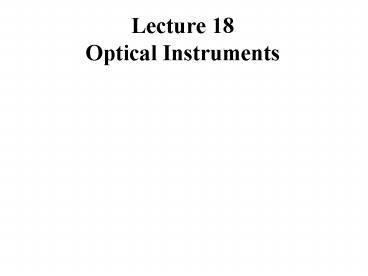Lecture 18 Optical Instruments PowerPoint PPT Presentation
Title: Lecture 18 Optical Instruments
1
Lecture 18Optical Instruments
Chapter 25
Outline
- The Camera and the Eye
- The Microscope and the Telescope
2
Results from geometric optics
Thin-lens equation
Lateral Magnification
1 1 1 ? ? ? p q f
? q M ?? p
For a system of two lenses, the image formed by
the first one is treated as the object for the
second one. The image formed by the second lens
is the final image of the system. The overall
magnification is the product of the
magnifications of the individual lenses.
3
The Camera
The camera is a simple optical system to produce
an image on film (we consider single-lens camera).
Additional information about the light intensity
(I) is needed. I is the rate at which energy is
received by film per unit area of the image (A).
I D2, where D is the lens diameter A q2, q ?
f ? A f2
I D2/f2
New parameter, f-number ? f/D ? lens speed
4
Diopter
The power P of a lens in diopters equals the
inverse of the focal length in meters P 1/f
A converging lens of f 1 m has P 1
diopter. A diverging lens of f ?1 m has P
? 1 diopter.
If the far point of the eye is 25 cm
(nearsightedness), a lens with f ? 25 cm would
correct the problem.
The power of this lens is
? 4 diopters (not ? 0.4!)
5
Concept of Resolution
Linear resolution is the minimum distance between
any two objects to be viewed separately. Angular
resolution is the minimum angle between any two
objects to be viewed separately.
6
Summary
- Simple treatment of light as rays in the
geometric optics approximation allows to design
powerful optical systems (cameras, correction
lenses, microscopes, and telescopes) - Angular magnification describes an apparent
increase of an object in size when a lens or a
combination of lenses is used compared to the
naked eye.
PowerShow.com is a leading presentation sharing website. It has millions of presentations already uploaded and available with 1,000s more being uploaded by its users every day. Whatever your area of interest, here you’ll be able to find and view presentations you’ll love and possibly download. And, best of all, it is completely free and easy to use.
You might even have a presentation you’d like to share with others. If so, just upload it to PowerShow.com. We’ll convert it to an HTML5 slideshow that includes all the media types you’ve already added: audio, video, music, pictures, animations and transition effects. Then you can share it with your target audience as well as PowerShow.com’s millions of monthly visitors. And, again, it’s all free.
About the Developers
PowerShow.com is brought to you by CrystalGraphics, the award-winning developer and market-leading publisher of rich-media enhancement products for presentations. Our product offerings include millions of PowerPoint templates, diagrams, animated 3D characters and more.

